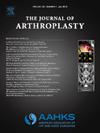Muscle Activity and Biomechanics While Descending a Staircase After Total Knee Arthroplasty: A Study Comparing Different Posterior Stabilized and Medial Ball-and-Socket Designs
IF 3.4
2区 医学
Q1 ORTHOPEDICS
引用次数: 0
Abstract
Background
Many patients report more difficulty when descending stairs compared to level walking after total knee arthroplasty (TKA). Different implant designs can affect knee biomechanics and muscle activity during gait, but their effect during stair descent is unclear. The purpose of this study was to evaluate knee biomechanics and muscle activations of quadriceps, hamstrings, and gastrocnemius muscles during a stair descent task in patients who underwent TKA with either a posterior stabilized (PS) or medial ball-and-socket (MBS) implant and to compare them to a group of healthy controls.
Methods
There were 28 TKA patients who were randomized to either an MBS (n = 14) or PS (n = 14) implant and were compared with 14 controls. Patients visited the biomechanics lab approximately 12 months after TKA, where knee biomechanics and muscle activity were measured as they descended a 3-step staircase.
Results
Compared to the MBS and control groups, the PS group descended the stairs with a reduced knee flexion angle and greater hamstring muscle activation throughout single limb support. Knee joint moments and power were similar between the MBS and PS groups, but neither reached the level of the control group.
Conclusions
Lower knee flexion angles and increased hamstring muscle activity indicated that the PS group descended the stairs with a stiffer knee gait pattern than the MBS group. The MBS implant design may provide additional stability as patients require less muscle activity than the PS group.
全膝关节置换术后下楼梯时的肌肉活动和生物力学:比较不同的后方稳定型和内侧球窝型设计的研究。
背景:许多患者表示,与平地行走相比,全膝关节置换术(TKA)后下楼梯更加困难。不同的植入物设计会影响步态时的膝关节生物力学和肌肉活动,但在下楼梯时的影响尚不清楚。本研究的目的是评估使用后稳定型(PS)或内侧球窝型(MBS)假体进行全膝关节置换术的患者在下楼梯时的膝关节生物力学以及股四头肌、腘绳肌和腓肠肌的肌肉活动情况,并将其与一组健康对照组进行比较:28名TKA患者随机接受了MBS(14人)或PS(14人)假体植入,并与14名对照组进行了比较。患者在 TKA 术后约 12 个月前往生物力学实验室,在下三阶楼梯时测量膝关节生物力学和肌肉活动:结果:与MBS组和对照组相比,PS组在下楼梯时膝关节屈曲角度减小,在整个单肢支撑过程中腿筋肌肉活动更强。MBS组和PS组的膝关节力矩和力量相似,但均未达到对照组的水平:结论:较低的膝关节屈曲角度和增加的腘绳肌活动表明,与 MBS 组相比,PS 组在下楼梯时膝关节步态较僵硬。与 PS 组相比,MBS 植入物的设计可提供额外的稳定性,因为患者需要的肌肉活动更少。
本文章由计算机程序翻译,如有差异,请以英文原文为准。
求助全文
约1分钟内获得全文
求助全文
来源期刊

Journal of Arthroplasty
医学-整形外科
CiteScore
7.00
自引率
20.00%
发文量
734
审稿时长
48 days
期刊介绍:
The Journal of Arthroplasty brings together the clinical and scientific foundations for joint replacement. This peer-reviewed journal publishes original research and manuscripts of the highest quality from all areas relating to joint replacement or the treatment of its complications, including those dealing with clinical series and experience, prosthetic design, biomechanics, biomaterials, metallurgy, biologic response to arthroplasty materials in vivo and in vitro.
 求助内容:
求助内容: 应助结果提醒方式:
应助结果提醒方式:


